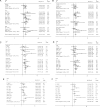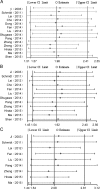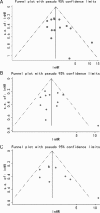Clinical value of lncRNA MALAT1 as a prognostic marker in human cancer: systematic review and meta-analysis
- PMID: 26423854
- PMCID: PMC4593150
- DOI: 10.1136/bmjopen-2015-008653
Clinical value of lncRNA MALAT1 as a prognostic marker in human cancer: systematic review and meta-analysis
Abstract
Background: Metastasis-associated lung adenocarcinoma transcript 1 (MALAT1) is found to be overexpressed and associated with clinicopathological features in patients with cancer.
Objectives: To evaluate the clinical value of MALAT1 as a prognostic marker in human cancers by a comprehensive meta-analysis of published studies.
Data sources: The data on the prognostic impact of MALAT1 in cancer were collected from 11 September 2003 to 10 July 2015.
Setting and participants: Fourteen eligible studies with a total of 1373 patients conducted in 3 countries (9 in China, 3 in Japan and 2 in Germany) were matched to our inclusion criteria.
Outcome measures: Pooled HRs with 95% CIs were calculated to estimate the strength of the link between MALAT1 and clinical prognoses. The combined HRs heterogeneity was tested using a χ(2)-based Cochran Q test and Higgins I(2) statistic. Publication bias was evaluated using a funnel plot with Egger's bias indicator test.
Results: A significant association between MALAT1 overexpression and poor overall survival (OS) (HR=1.95; 95% CI 1.57 to 2.41) was observed. Residence region (Germany and China), cancer type (respiratory, digestive or other system disease), sample size and paper quality did not alter the predictive value of MALAT1 on OS in investigated cancers. MALAT1 expression was an independent prognostic marker for OS in patients with cancer using univariate and multivariate analyses. Subgroup analysis showed that the elevated MALAT1 appeared to be a powerful prognostic marker for patients with respiratory, digestive and other system cancers. A similar effect was also seen in different regions. Furthermore, the overexpression of MALAT1 was associated with disease-free, recurrence-free and progression-free survivals.
Conclusions: MALAT1 may potentially be used as a new prognostic marker to predict poorer survival of patients with cancer. More clinical studies on the different types of human cancer not yet investigated need to be conducted.
Keywords: MOLECULAR BIOLOGY.
Published by the BMJ Publishing Group Limited. For permission to use (where not already granted under a licence) please go to http://group.bmj.com/group/rights-licensing/permissions.
Figures





References
Publication types
MeSH terms
Substances
LinkOut - more resources
Full Text Sources
Other Literature Sources
